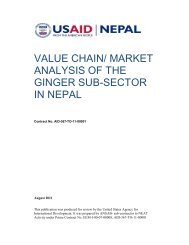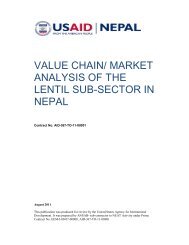value chain/ market analysis of the orthodox tea sub ... - Nepal Trade
value chain/ market analysis of the orthodox tea sub ... - Nepal Trade
value chain/ market analysis of the orthodox tea sub ... - Nepal Trade
Create successful ePaper yourself
Turn your PDF publications into a flip-book with our unique Google optimized e-Paper software.
Green leaf is priced depending upon <strong>the</strong> grade. Cooperatives and individual farmers can alsogo for contract agreement with processors for supplying leaf at prior fixed rate. Mostly,selling is done in credit. Incentives are <strong>of</strong>fered by some processors to farmers. There is rareincidence <strong>of</strong> providing advance payment to <strong>the</strong> producers. In totality, <strong>the</strong> governance <strong>of</strong><strong>orthodox</strong> <strong>tea</strong> <strong>value</strong> <strong>chain</strong> is buyer driven with low trust between various actors especiallyfarmers and processors.3.7.1 Horizontal and vertical linkagesVertical Linkages: Vertical linkages can be attained through cooperation between differentactors or firms, and <strong>the</strong>y have <strong>the</strong> benefits <strong>of</strong> transferring skills from one actor to ano<strong>the</strong>r. In<strong>the</strong> <strong>orthodox</strong> <strong>tea</strong> <strong>value</strong> <strong>chain</strong>, vertical linkages exist between farmers, processors, andtraders/exporters. Farmers sell <strong>the</strong>ir green leaf to nearby processors (mostly large andmedium factories) mostly randomly. Some provide <strong>the</strong>ir leaf to cooperatives for collectiveselling. Some cooperatives and individual farmers make agreements with factories for <strong>the</strong>supply <strong>of</strong> green leaf. The agreement can be in written contract form or simply a verbalcommitment. In some cases, factories provide incentives for production and input purchases.Usually, <strong>the</strong> payment <strong>of</strong> <strong>the</strong> green leaf is done at <strong>the</strong> time <strong>of</strong> sale or in credit. The processorsmostly are exporters <strong>the</strong>mselves. Some sell made <strong>tea</strong> to o<strong>the</strong>r traders/exporters. Thetraders/exporters have <strong>the</strong>ir own clients to whom <strong>the</strong>y supply <strong>the</strong> end product. Overall, <strong>the</strong>reare good vertical linkages between producers, processors and traders/exporters.Horizontal linkages: Horizontal linkages represent <strong>the</strong> relationships among different actorsoperating at <strong>the</strong> same level <strong>of</strong> a <strong>value</strong> <strong>chain</strong>: It can be seen at producers level where <strong>the</strong>re arevarious Farmer Based Organizations (FBOs) and cooperatives operating within productionpockets. Group members organize meetings periodically and share about <strong>the</strong> status <strong>of</strong>production, input procurements, and output <strong>market</strong>ing. CTCF is <strong>the</strong> umbrella organization <strong>of</strong>various district cooperatives and is providing assistance to farmers in production and o<strong>the</strong>rissues. NTCDB also works parallel with cooperatives and farmers in production as well as<strong>market</strong> promotion. Fur<strong>the</strong>rmore, HOTPA has been conducting several activities towardsquality production and policy lobbying and advocacy. For collective <strong>market</strong>ing, HIMCOOPhas been actively assisting in <strong>market</strong>ing and promotion <strong>of</strong> <strong>Nepal</strong> <strong>tea</strong> from various processors.However, HIMCOOP has not been able to do higher trading as most <strong>of</strong> <strong>the</strong> processors aredealing directly with buyers. This has hampered <strong>the</strong> income <strong>of</strong> HIMCOOP.Various development organizations and donor projects are supporting <strong>the</strong> promotion <strong>of</strong> <strong>the</strong><strong>tea</strong> sector from production to <strong>market</strong>ing. Some <strong>of</strong> <strong>the</strong> organizations are USAID/ <strong>Nepal</strong>, GIZ,SNV, Winrock International, IDE, JICA, and TEASEC. The GON and its agencies have alsoimplemented programs and policies intended to support <strong>the</strong> <strong>tea</strong> sector, however, suchprograms and policies have not been regarded as successful. A competitive <strong>analysis</strong> compares<strong>the</strong> commercialization <strong>of</strong> <strong>the</strong> <strong>orthodox</strong> <strong>tea</strong> sector through export promotion anddiversification to existing industry levels and determines <strong>the</strong> nature <strong>of</strong> challenges that <strong>the</strong>sector faces. This <strong>analysis</strong> identifies strengths, weakness, opportunities and threats(See Table 4).Value Chain/Market Analysis-Orthodox Tea 28






